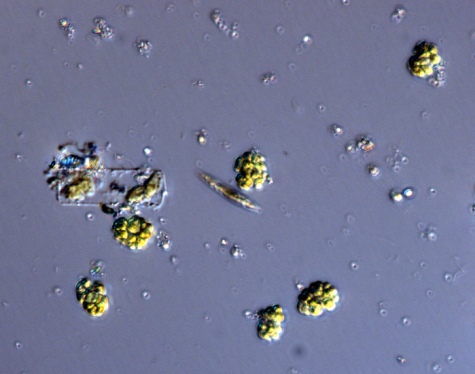



|
 |
Synonym(s)
Entomosigma akashiwo Hada
Heterosigma akashiwo (Hada) Hada
Heterosigma carterae (Hulburt) F. J. R. Taylor
(Horner 2002)
Classification
(Guiry and Guiry 2011)
Lifestyle
Cyst
"A thick-walled dormant cell" (Horner 2002).
cysts that are covered with mucilage (Montagnes 2006). These cysts are yellow-green to brown (Montagnes 2006). H. akashiwo cysts sink to the sea floor and can germinate the following year, producing another crop of swimming cells when conditions allow (Rensel et al. 2010).Description
Chloromonad
A member of the order Chloromonadida. Chloromonads are protists, have two flagella (one trailing, one extending forward) and have many disk-shaped chloroplasts (Encyclopedia Britannica 2011). Some species are principally responsible for farmed salmon kills since 1986. Large blooms have been observed along the BC coast (Taylor and Harrison 2002). Local example: Heterosigma akashiwo.
chloromonad flagellate (i.e., it has two flagella, one trailing and one forward; Taylor and Haigh 1993). The two flagella are equal in length and each about same length as the cell. The CloseAnterior
The front. The part of the cell in the direction of movement. Opposite of posterior (HPP 2003).
anterior flagellum is used for swimming (Montagnes 2006). H. akashiwo cells swim rapidly and can rotate and change directions quickly (Rensel et al. 2010). H. akashiwo has 10 - 30 golden-brown chloroplasts and many mucocysts (Rensel et al. 2010). When preserved with chemical fixatives, the cell membrane shrinks tightly around the cell CloseOrganelle
A unit within the cell that serves a specific function and is usually enclosed by an individual lipid bilayer (membrane).
organelles, giving the cell a lumpy look, similar to a blackberry.Measurements
Similar species
Harmful effects
Reactive oxygen species
Chemically reactive compounds that contain oxygen (i.e., oxygen ions or peroxides). They are natural byproducts of oxygen metabolism. Levels in the cell may increase with increased environmental stress (Apel and Hirt 2004).
reactive oxygen species (ROS) such as hydrogen peroxide, which cause gill damage and respiratory failure (Rensel et al. 2010).Habitat
Distribution
Growth conditions
Euryhaline
Describing organisms that are able to withstand a wide range of salinities in the environment (e.g., fresh, brackish, salt).
euryhaline and can grow at salinities as low as 5, though it grows significantly faster at salinities of 10 or higher (Rensel et al. 2010).Environmental Ranges
Temperature range (°C): -1.948 - 12.224
Nitrate (μmol L-1): 1.278 - 7.035
Salinity: 5 - 34.704
Oxygen (mL L-1): 6.447 - 8.728
Phosphate (μmol L-1): 0.208 - 1.268
Close
Silicic acid
A general term to describe chemical compounds containing silicon, oxygen and hydrogen with a general formula of [SiOx(OH)4-2x]n. Diatoms polymerize silicic acid into biogenic silica to form their frustules (Azam and Chisholm 1976).
Silicate (μmol L-1): 1.190 - 15.128(EOL 2011)
Bloom characteristics
Stratification
The development of distinct non-mixing layers in the water column resulting from a steep gradient in density, which is caused by differences in temperature and/or salinity.
stratification caused by the spring CloseFreshet
A great rise or overflow of a river from heavy rains or spring thaw. In the Strait of Georgia, this usually occurs from March to June. (pers. comm. D. Cassis).
freshet (the massive peak freshwater discharge by rivers; Rensel et al. 2010). Blooms in the Strait of Georgia coincide with the rise of water temperature to a minimum of 15 °C and decrease in salinity below 15. At Jericho pier in English Bay, Vancouver, this occurs in late May or early June, when freshwater runoff peaks and the Fraser River plume is largest. This stratifies the CloseWater column
Referring to a water system from the surface to the bottom sediments. This can be used to understand processes of stratification, mixing and their relationship to nutrient transport. Temperature, salinity, pH, and nutrient levels often vary along the length of the water column.
water column in the Strait and supplies various CloseNutrients
Various chemical substances that an organism needs for metabolism (i.e., to live and grow). These are usually taken up from the environment. Some examples include nitrate, phosphate, silica (for diatoms), iron, copper, etc. Some nutrients, like copper, are required for growth, but can also be toxic at high levels.
nutrients, such as iron (Taylor and Haigh 1993). H. akashiwo cell concentration in the Strait of Georgia can exceed 500 million cells L-1 of seawater during blooms (Taylor and Haigh 1993).References
Encyclopedia of Life (EOL). Heterosigma akashiwo (Hada) sournia. http://www.eol.org/pages/911906. Accessed 02 July 2011.
Guiry, M. D. and Guiry, G. M. 2011. Heterosigma akashiwo (Hada) sournia. http://www.algaebase.org. Accessed 18 July 2011.
Horner, R. A. 2002. A Taxonomic Guide To Some Common Phytoplankton. Biopress Limited, Dorset Press, Dorchester, UK. 200.
Montagnes, D. 2006. Guide to Harmful Phytoplankton. University of Liverpool. UK. http://www.liv.ac.uk/hab/Data%20sheets/h_akas.htm. Accessed 16 Jan 2012.
Rensel, J. E. 2007. Fish kills from the harmful alga Heterosigma akashiwo in Puget Sound: Recent blooms and review. Rensel Associates Aquatic Sciences. Arlington, Washington, USA. 58.
Rensel, J. E., Haigh, N. and Tynan, T. J. 2010. Fraser river sockeye salmon marine survival decline and harmful blooms of Heterosigma akashiwo. Harmful Algae. 10(1): 98-115.
Taylor, F. J. R., Haigh, R. 1993. The Ecology of Fish-Killing Blooms of the Chloromonad Flagellate Heterosigma akashiwo in the Strait of Georgia and Adjacent Waters. In: Smayda, T. J. and Shimizu, Y. (eds.). Toxic Phytoplankton Blooms in the Sea. Elsevier, Amsterdam. 705-771
